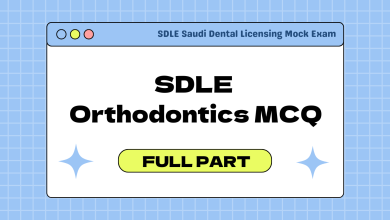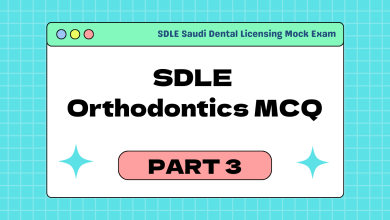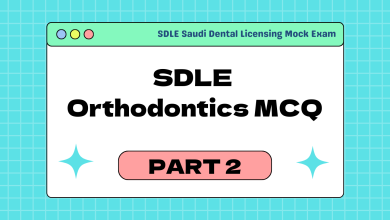Orthodontics SDLE MCQ | Part 1

The Ultimate Guide to Conquering the SDLE: Your Strategic Blueprint for Success
Preparing for the SDLE exam is a significant milestone in every aspiring dentist’s career. It’s more than just a test of memorized facts; it’s a comprehensive assessment of your clinical judgment and deep understanding of various dental specialties. Many candidates feel overwhelmed by the vast amount of information, unsure of where to start or how to focus their efforts efficiently.
This in-depth guide is designed to be your roadmap. We will walk you through proven, strategic steps to build a robust study plan, choose the right topics, and approach the exam with the confidence needed to excel.
Part 1: The Art of Smart Topic Selection
One of the most common pitfalls in exam preparation is trying to learn everything at once. A strategic approach to selecting your study topics is not just helpful—it’s crucial for efficient and effective learning.
Why is Topic Selection a Game-Changer?
Your study time is your most valuable resource. Without a clear plan, you can easily spend hours on low-yield information while neglecting the foundational concepts that form the core of the exam. Intelligent topic selection ensures that every hour you invest brings you a higher return in knowledge and exam readiness.
Your Step-by-Step Strategy to Begin:
-
Start with Diagnosis in Every Major Subject.
Before diving deep into complex procedures, ground yourself in the diagnosis for each core specialty: Restorative (Resto), Endodontics (Endo), Prosthodontics (Pros), and Periodontics (Perio). This approach is powerful because it builds critical connections between the subjects. Since most exam questions are clinically-based, understanding how to diagnose a problem is the first and most essential step toward finding the correct solution. You’ll start to see the “big picture” of patient care. -
Identify and Master the Foundational Topics.
Every specialty has a set of fundamental principles that appear again and again. Your initial goal is not to become an expert in every rare condition, but to achieve complete mastery over these core topics. Think of it as building a strong skeleton; once that is in place, you can easily attach more detailed knowledge.
Part 2: Your Detailed Study Blueprint: What to Focus On
The SDLE exam is designed to test your basic knowledge, which means it consistently draws from a predictable set of high-yield topics within each specialty.
A Deep Dive into Key Specialties:
1. Restorative Dentistry
-
Diagnosis: The ICDAS System (International Caries Detection and Assessment System) is paramount. You must know it inside and out.
-
Classifications: Be thoroughly familiar with cavity classifications (Black’s, etc.).
-
Amalgam: Understand its phases, types of failures, and preparation design principles.
-
Partial Coverage: Differentiate clearly between inlays and onlays, including their indications and preparations.
Understanding ICDAS: A Practical Guide
ICDAS provides a standardized method for assessing caries. Here is a clear breakdown:
| Code | Description |
|---|---|
| 0 | Sound tooth surface |
| 1 | First visual change in enamel (seen only after drying) |
| 2 | Distinct visual change in enamel |
| 3 | Localized enamel breakdown without visible dentin |
| 4 | Underlying dark shadow from dentin |
| 5 | Distinct cavity with visible dentin |
| 6 | Extensive distinct cavity with visible dentin |
2. Endodontics
-
Diagnosis: Master pulp testing, percussion, palpation, and radiographic interpretation.
-
Materials: Know the composition, pH, and side effects of key materials like irrigants and sealers.
-
Surgical Procedures: Understand the indications and steps for an apicectomy.
-
Regeneration: Be clear on the indications and materials used in regenerative endodontics.
-
Files: This is a favorite area for examiners. Learn the colors, cross-sections, and specific properties of different file systems, especially hand files like K-files and H-files.
-
Rotary Systems: Understand the basic principles and safety protocols.
3. Periodontics
-
Diagnosis: Be fluent in both the old and new (2017) classification systems for periodontal diseases.
-
Probes: Know the different types of probes and their specific markings.
-
Periodontal Diseases: Understand the etiology and characteristics of gingivitis and various forms of periodontitis.
-
Instruments: Identify and know the uses of scalers, Gracey curettes, and water irrigation systems.
-
Maintenance: Understand the protocols for supportive periodontal care and re-evaluation.
Part 3: Mastering the Question Bank: A Strategic Tool, Not a Crutch
Many candidates use question banks, but few use them optimally. The key is to approach them after you have built a strong foundational knowledge.
How to Truly Leverage Old Questions to Your Advantage:
-
Look for Recurring Patterns. As you go through question sets, you will start to notice that certain topics are tested repeatedly. These are your high-yield areas. Keep a log of these topics and ensure you know them cold.
-
Study the Topic, Not Just the Question. Don’t just memorize the answer to a specific question. When you encounter a question about, for example, “Wharton’s tumor,” don’t just note that the answer is the submandibular gland. Instead, open your textbook and read the entire section on salivary gland tumors. This transforms a single question into a comprehensive learning session.
-
Always Cross-Reference with Reliable Sources. Your primary sources of information should be standard textbooks and current scientific literature. Use the question bank to identify gaps in your knowledge, and then fill those gaps with authoritative material.
-
Take Notes on Every Answer Choice. When reviewing a question, don’t just look at the correct answer. For every incorrect option, write down a brief note explaining why it is wrong. This active learning technique forces you to cover a much broader scope of information and deepens your understanding significantly.
-
Learn from Colleagues. Connect with peers who have recently taken the exam. They can provide valuable insights into the exam’s focus and atmosphere. However, filter this advice—everyone’s experience is subjective.
-
Answer Questions on Your Own First. Resist the temptation to immediately look at the answers. Challenge yourself to reason through the question independently. This builds critical thinking and problem-solving skills that are essential for the exam.
Part 4: Demystifying Exam Difficulty and Building Confidence
It’s natural to feel anxious, especially when you hear stories about “impossible” questions. Let’s reframe that thinking.
Are All the Questions Difficult? Absolutely Not.
Any well-constructed exam has a mix of easy, moderate, and difficult questions. The difficult ones are typically a small percentage, while the bulk of the exam consists of questions of easy to moderate difficulty. The psychological trap is that our brains tend to remember and talk about the challenging questions we faced. This creates a false impression that the entire exam was overwhelmingly hard.
The Takeaway: Don’t let post-exam stories from colleagues panic you. If you find a subject challenging, go back and solidify your basic understanding in that area. A strong foundation will allow you to confidently answer the majority of the questions.
Part 5: Essential Mindset and Final Takeaways for Success
Your preparation isn’t just about intellectual knowledge; it’s also about the right mindset and habits.
Your Success Mantra:
-
Invest Your Time Wisely. The exam is challenging but passable for those who are well-prepared. Consistent, focused study is an investment that will pay off immensely, not just for the exam but for your clinical career.
-
Rethink Study Groups. Avoid using study groups for initial learning. They often become inefficient social sessions. However, they can be excellent for final revision, quizzing each other, and discussing complex topics after you have done your individual studying.
-
Build an Unshakeable Foundation. Prioritize depth over breadth in your core subjects. A deep understanding of fundamental principles will allow you to deduce answers to questions you may not have directly studied.
-
Aim for Mastery, Not Just Passing. Go into the exam with the goal of truly understanding the material. This mindset shift reduces anxiety and fosters a more profound, long-lasting knowledge that will serve you far beyond the exam hall.
Examples of Orthodontics SDLE MCQ
1. Category: Diagnosis & Classification
Question: A cephalometric analysis reveals an SNA angle of 82°, SNB angle of 76°, and an ANB angle of 6°. How is this skeletal relationship classified?
A) Skeletal Class I
B) Skeletal Class II
C) Skeletal Class III
D) Within normal limits
Correct Answer: 2
Explanation: An ANB angle of 6° is indicative of a Skeletal Class II relationship, where the maxilla is positioned anteriorly relative to the mandible. Normal ANB is typically 2-4°.
2. Category: Treatment Planning
Question: What is the primary goal of using a Facemask (Reverse-Pull Headgear) in a growing patient?
A) To restrain maxillary growth
B) To promote forward growth of the maxilla
C) To restrain mandibular growth
D) To distalize maxillary molars
Correct Answer: 2
Explanation: A Facemask applies forward and downward force on the maxilla, aiming to stimulate or guide its forward growth in patients with maxillary deficiency, often associated with Class III malocclusions.
3. Category: Biology of Tooth Movement
Question: Which type of orthodontic force is considered most ideal for efficient and physiologically sound tooth movement?
A) Heavy continuous force
B) Light continuous force
C) Heavy intermittent force
D) Light intermittent force
Correct Answer: 2
Explanation: Light continuous force promotes direct bone resorption (frontal resorption) on the pressure side, leading to more efficient, predictable, and less painful tooth movement with a lower risk of root resorption.
4. Category: Appliances
Question: A 13-year-old patient presents with a skeletal posterior crossbite due to a narrow maxilla. Which appliance is most appropriate for achieving skeletal expansion?
A) Quad Helix
B) Hawley Retainer with a Z-spring
C) Rapid Palatal Expander (Hyrax/Haas)
D) Invisalign aligners
Correct Answer: 3
Explanation: Rapid Palatal Expanders (RPEs) like Hyrax or Haas are fixed appliances that apply heavy forces to open the midpalatal suture, resulting in true skeletal expansion, which is crucial during adolescence.
5. Category: Complications
Question: A patient undergoing orthodontic treatment develops generalized gingival recession, particularly on teeth being moved labially. What is the most significant predisposing risk factor?
A) Use of elastomeric chains
B) Thin gingival biotype
C) Poor oral hygiene
D) Type of bracket used
Correct Answer: 2
Explanation: A thin gingival biotype, often associated with a scalloped gingival margin and thin bone, is a major risk factor for recession when teeth are moved outside the alveolar bone envelope, especially facially.
6. Category: Adjunctive Procedures
Question: A patient desires accelerated orthodontic treatment. Which surgical procedure performed by a periodontist can increase the rate of tooth movement by inducing a regional acceleratory phenomenon (RAP)?
A) Frenectomy
B) Crown Lengthening
C) Alveolar Decortication
D) Free Gingival Graft
Correct Answer: 3
Explanation: Alveolar decortication involves making small surgical cuts in the bone around the teeth. This transiently increases bone turnover (RAP), allowing teeth to move faster when force is applied.
7. Category: Growth Modification
Question: For a pediatric patient with a retrognathic mandible (Class II malocclusion), which type of appliance is primarily used to enhance mandibular growth?
A) High-Pull Headgear
B) Facemask
C) Functional Appliance (e.g., Twin Block)
D) Palatal Expander
Correct Answer: 3
Explanation: Functional appliances like the Twin Block postured the mandible forward, which is believed to stimulate or guide condylar growth and remodeling, thereby improving the Class II profile.
8. Category: Retention
Question: What is the most common cause of orthodontic relapse after correction of rotated teeth?
A) Failure to wear retainers
B) Supracrestal gingival fibers
C) Occlusal interferences
D) Growth of the mandible
Correct Answer: 2
Explanation: The transseptal (supracrestal) gingival fibers are very elastic and have a long memory. After a tooth is derotated, these fibers tend to pull the tooth back toward its original rotated position, making permanent retention often necessary.
9. Category: Treatment Planning
Question: A 25-year-old patient presents with a severe skeletal Class II malocclusion, a 10mm overjet, and mandibular deficiency. What is the most appropriate comprehensive treatment plan?
A) Orthodontic camouflage with upper premolar extractions
B) Growth modification with a functional appliance
C) Orthognathic surgery (Bimaxillary osteotomy)
D) Orthodontic treatment with interproximal reduction
Correct Answer: 3
Explanation: In a non-growing adult with a severe skeletal discrepancy, orthognathic surgery is required to reposition the jaws and achieve an optimal functional and aesthetic result, as camouflage or growth modification is not feasible.
10. Category: Diagnosis
Question: What is the defining characteristic of a “Pseudo Class III” malocclusion?
A) A true skeletal mandibular prognathism
B) A habitual forward posturing of the mandible to achieve incisor contact, often due to an interference
C) A genetic predisposition to Class III traits
D) A result of premature loss of posterior teeth
Correct Answer: 2
Explanation: Pseudo Class III is a functional malocclusion where the patient shifts the mandible forward to close into a single tooth contact, avoiding a more posterior initial contact. The underlying skeletal pattern is often Class I.
Conclusion: Your Journey to Success Starts Now
The path to SDLE success is a marathon, not a sprint. It requires careful planning, disciplined execution, and a positive, resilient mindset. Start by strategically selecting your topics, build your knowledge layer by layer, and use practice questions as a diagnostic tool to refine your understanding.
Remember, confidence is born from competence. Every well-understood topic, every mastered concept, and every strategically studied hour brings you closer to your goal.
You have the capability and the resources to excel. Trust your preparation, stay focused on your plan, and walk into the exam ready to demonstrate your knowledge. Good luck





